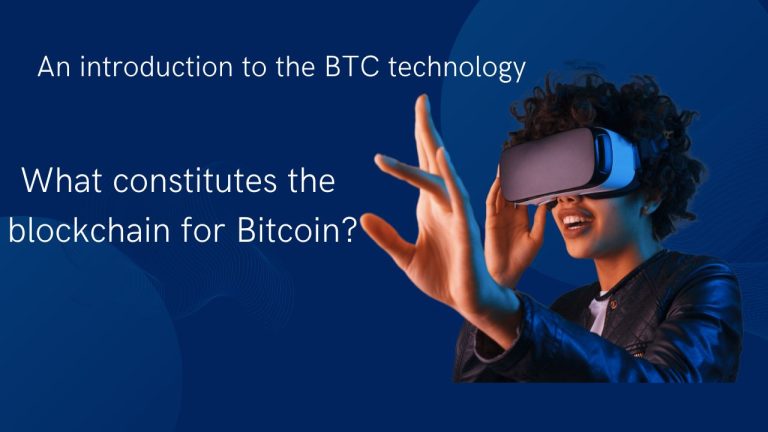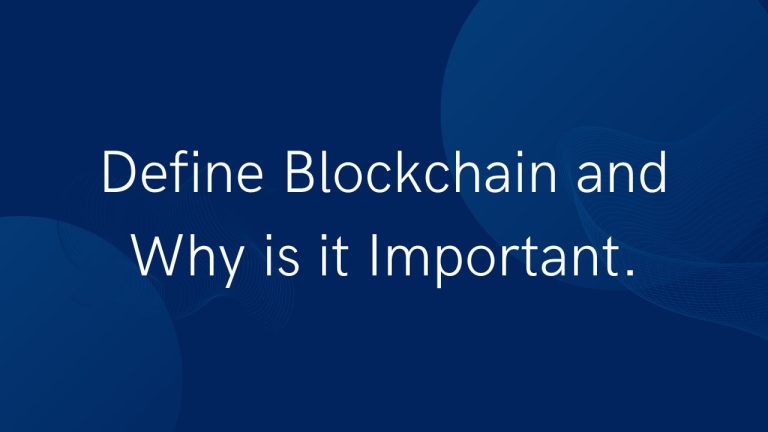The blockchain technology explanation.
According to Wikipedia, a blockchain is “a distributed database that maintains a continuously expanding list of ordered records, called blocks,” which are “connected using encryption. Each block includes transaction information, a timestamp, and a cryptographic hash of the one before it.
“ A blockchain is a decentralized, distributed, and open digital ledger that is utilized to log transactions across numerous computers in a way that prevents the record from being changed retrospectively without changing all succeeding blocks and obtaining network consent”.
Blockchain: Why Is It Important?
Due to its ability to scale transparency, eliminate fraud, and reduce security threats, blockchain is an incredibly revolutionary and exciting technology.
Blockchain technology gained notoriety through its connection to cryptocurrencies and NFTs, but it has subsequently developed into a management tool for a variety of international companies. At the moment, blockchain technology is being utilized to transform gaming, protect healthcare data, give transparency to the food supply chain, and fundamentally change how we handle data and ownership.
Blockchain describes in detail
Blockchains are distributed, decentralized digital ledgers that are impenetrable to tampering and exist without a central repository. They allow users to enter transactions in a group’s shared ledger at the most fundamental level. As a result, under normal blockchain network operation, no transaction may be changed after it has been published.
Modern cryptocurrencies, or electronic cash that is secured by cryptographic procedures rather than a central repository or authority, were developed in 2008 after the blockchain idea was integrated with a variety of other technologies and computing concepts.

Blockchain applications are typically developed with a particular objective or purpose in mind. Examples of functions include distributed ledger systems for businesses, smart contracts, and cryptocurrencies.
The first cryptocurrency built on a blockchain, Bitcoin, allows users to share data openly so that other users may independently confirm the transaction’s legitimacy. Blockchain technology named after its extensive use of cryptographic operations is the foundation upon which cryptocurrencies are created.
Users utilize public and private keys to digitally sign and securely transact within the system. In blockchain networks powered by cryptocurrencies, users can solve puzzles using cryptographic hash functions in the hopes of being rewarded with a set amount of money.
A steady stream of innovations has been made in the realm of blockchain technology, and as new platforms are frequently launched, the landscape is always changing. Blockchain technology can be used to create a permanent, open, and transparent ledger system for gathering sales data, monitoring digital consumption, and paying content providers like musicians in addition to cryptocurrencies.
Blockchain technology is described in this article along with an outline of how it functions.
How does the blockchain technology work properly
The main objective of a blockchain is to allow people, especially those who don’t trust one another, to exchange critical data in a secure, impenetrable manner.
The essential principles in the blockchain are hash function, blocks, nodes, miners, wallets, digital signatures, and protocols.
function hash
Imagine that a group of ten people decided to create a new form of money. To ensure the coins in their new monetary ecosystem are valid, they must monitor the flow of money. A single person, may we say, Bob decided to record each action in a journal. Another individual, let’s name him Jack decided to commit theft. He altered the diary entries to conceal this.
Then, suddenly, Bob discovered that his diary had been tampered with. To avoid future tampering, he decided to alter the format of his diary. As indicated in the table below, he utilized a program called a hash function to convert text into a collection of numbers and letters.
The letters are converted into character strings by the use of the secure hash technique or SHA. Bob can select from a variety of SHA kinds, each with a unique level of intricacy and purpose.
Bob observed that someone had gone over the diary once more. He chose to make each transaction’s record more difficult. He added a new hash that was created from the previous hash that was captured after each record. Each entry is therefore dependent upon the one before it.
Jack will need to modify the hash in each earlier entry if he attempts to edit the record. But Jack was a determined thief, and he spent the entire night adding up all the hashes.
Bob inserted a different, random number after each record since he didn’t want to give up. A “nonce” is what we call this number. Nonces should be selected so that the resultant hash contains two zeros at the end.
With Bob’s new input technique, Jack would now need to spend countless hours figuring out the nonce for each line to fabricate records.
Even computers find it challenging to understand nonces, yet the task is doable since miners compete to find them as part of the blockchain mining process.
Blocks
The genesis block, which serves as the foundation for this blockchain, is composed of the first 5,000 transactions in Bob’s original spreadsheet. Transactions happen rapidly and frequently now that this currency is widely accepted. New blocks are generated, each of which has a capacity of 5,000 transactions, can’t be altered, and has a code that corresponds to previous blocks.
Assume that a new block is added to this blockchain every ten minutes. It does it without being asked. The computers are not given this instruction by a master or central computer.
The spreadsheet, ledger, or register cannot be changed after it has been updated. Therefore, it cannot be faked. Only new entries can be made to it. On the network, the registry is updated simultaneously on every computer. Blockchain technology modifications require agreement from the majority of users who are connected to the network.
A block typically includes a date, a reference to the block before it, the transactions, and the computational challenge that had to be overcome before the block could be added to the blockchain technology. Fraud within the blockchain is virtually difficult due to the distributed network of nodes that must come to a consensus.
Nodes
Bob maintained the journal in this way for a little time. But as fresh transactions kept happening, he soon felt overwhelmed by the volume of records and realized that his current setup was untenable. Consequently, he changed his journal to a one-page spreadsheet as soon as it reached 5,000 transactions. Mary verified the veracity of every transaction.
Bob then distributed his spreadsheet to 3,000 other computers, each of which was situated in a different area of the world. These devices are referred to as nodes. These nodes must each authorize a transaction before it can take place, and they individually verify its legality. An electronic vote takes place once each node has verified a transaction. The transaction may appear legitimate to some nodes while appearing fraudulent to others.
A copy of the spreadsheet diary is present in each node. Every node verifies the accuracy of every transaction. A transaction is added to a block if a majority of nodes deem it to be genuine.
Now, all the other machines will still have the original hash if Jack wants to update a single entry in the spreadsheet journal. They would not permit the alteration to take place.
computerized signature
You need a wallet, which is an address, and a private key to complete a transaction. A series of arbitrary numbers make up the private key. The private key, however, needs to be kept a secret, unlike the address. A connected wallet’s associated private key controls the money there.
Anyone wishing to send Bitcoin to anyone else must first sign the message containing the transaction using their private key. The foundation of encryption and cryptography is a system of two keys: a private key and a public key, and its use predates the invention of blockchain technology a very long time. It was initially put forth in the 1970s.
The message is broadcast to the blockchain network once it has been sent. After that, the network of nodes examines the message to determine whether the transaction it includes is legitimate. A block is created for the transaction if it validates its validity. After that, it cannot have its information modified.
Define the blockchain’s business advantages.
Although a blockchain serves primarily as a database for recording transactions, it offers many advantages over conventional databases. Most significantly, it eliminates the potential for tampering by a bad party and offers the following business advantages:
Time reduction.
Blockchain reduces transaction processing times from days to minutes. Settlement of transactions happens more quickly since central authority verification is not required.
Cost reductions.
Less supervision is needed during transactions. The direct exchange of valuables between parties is permitted. Due to users’ access to a shared ledger, blockchain technology avoids effort duplication.
Increased security.
The security characteristics of blockchain technology guard against fraud, manipulation, and cybercrime.
Cryptographic keys: what are they?
A series of numbers and letters make up a cryptographic key. Key generators, often known as keygens, create cryptographic keys. These keygens generate keys using extremely complex mathematics involving prime integers.
Protocols Blockchain technology is made up of many built-in rules and distinct behavior requirements. These requirements are known as protocols. Blockchain functions primarily as a distributed, peer-to-peer, secured information database thanks to the application of particular protocols.
Even though the network is fully autonomous and uncontrolled, blockchain protocols make sure it functions as intended by its designers.
Here are several instances of blockchain protocols in use:
- The hash number from the preceding block must be included in the input data for each hash number.
- After 210,000 blocks have been mined, the payout for a successful block is reduced by half. This is referred to as halving for Bitcoin (BTC). Bitcoin experiences a halving event every four years because, at 10 minutes per block, mining 210,000 blocks takes around four years.
- Mining difficulty is updated every 2,016 blocks to maintain the time required to mine one block at roughly 10 minutes. In essence, mining difficulty balances the network to take into consideration the number of miners. Blocks become more challenging to mine as a result of increased competition brought on by more miners. Because there are fewer miners, mining blocks is easier on average, which encourages miners to join.
Benefits and drawbacks of blockchain technology
A decentralized database that functions as a distributed ledger is how the bulk of blockchains are constructed. These blockchain ledgers track and store data in chronologically ordered blocks that are connected by cryptographic proofs.
The advancement of blockchain technology has produced many advantages for a variety of industries, including improved security in instances where there is no basis for trust. Decentralization, though, has some very real disadvantages. For instance, blockchains are less efficient than conventional centralized databases and need more storage.
What is blockchain decentralization, and why is it significant?
Distributed databases are essentially what blockchains are. The blockchain serves as the database, and each node has access to the entire chain. There is no central node or computer that controls the data it holds. Each node can verify the blockchain’s records. Everything is handled without the involvement of single or multiple middlemen.
It is a crucial part of blockchain systems since it is architecturally decentralized and has no single point of failure that might bring the system down. However, because a blockchain is a dispersed network that executes predefined operations, its nodes are logically centralized.
A peer-to-peer network
Communication always takes place directly between peers during decentralized peer-to-peer (P2P) transmission as opposed to going through a central node. Each node stores information about what is happening on the blockchain, which is then transmitted to neighboring nodes. Information travels this way over the entire network.
Is blockchain technology secure?
Although not impervious to hacking, blockchain has a stronger line of defense due to its decentralized structure. To alter a distributed ledger, a hacker or criminal would need to have access to more than half of all the machines.
Everyone with a computer and an internet connection can access the largest and most well-known blockchain networks, including Bitcoin and Ethereum (ETH). On a blockchain network, more users tend to increase security rather than raise security issues. More nodes participating means that more people are evaluating one another’s work and reporting dishonest people. Contrary to popular belief, this is one of the reasons why private blockchain networks that require an invitation to join may be more prone to hacking and manipulation.
Blockchain is also helpful in thwarting “double-spending” attacks on payments and financial transactions. Attacks on cryptocurrencies are a major source of worry. In a double-spending assault, a user will spend their cryptocurrency more than once. This issue does not arise while working with cash.
You can no longer use $3 to buy anything else after you spend it on a cup of coffee. In contrast, there is a possibility that a user will spend cryptocurrency more than once before the network realizes it.
Blockchain technology can be used to aid with this. A cryptocurrency’s blockchain requires consensus on the order of transactions, confirmation of the most recent transaction, and publication of that transaction for public viewing, all of which contribute to the network’s security.
Cryptocurrency and Hyperledger
To facilitate the collaborative development of blockchain-based distributed ledgers, the Linux Foundation launched Hyperledger in December 2015. It is an umbrella project for open-source blockchains and related tools.
Participants in Hyperledger think that “only an Open Source, collaborative software development model can assure the transparency, longevity, interoperability, and support required to advance blockchain technology to broad commercial usage.”
The Hyperledger project’s goal is to “advance cross-industry collaboration by developing blockchains and distributed ledgers, with a specific focus on improving the performance and reliability of these systems (as compared to Major technological, financial, and supply chain firms should be able to use them to support international commercial transactions (compared to comparable coin designs).
Blockchain vs. Bitcoin
The most well-known and profitable cryptocurrency to date, Bitcoin was first presented in 2009 and has since grown in popularity. Due to its decentralized nature, which prevents a central authority or bank from managing its supply, bitcoin is extremely popular. This also means that using Bitcoin entails no transaction fees and anonymous transactions.
Blockchain is a database of exchanges that have occurred between two parties, with blocks of data including details about each exchange being added to the chain in the order in which they occur. The Blockchain is always growing as new blocks are added to it, making it more difficult to change a record as additional blocks are added after it.
What industries may use blockchain technology?
This article’s final section will go through a few of the many uses of blockchain technology. “Smart contracts” are particularly well suited to blockchain technology. What precisely are smart contracts, then?
Similar to how regular contracts work, smart contracts specify the limitations and consequences of a given agreement. However the key distinction is that such commitments are automatically enforced by smart contracts. Smart contracts can be discharged due to their coding when certain conditions are met.
Financial independence
Decentralized finance, or Defi, is the application of blockchain technology that gives users access to services that are comparable to those found in the mainstream financial industry but in a decentralized setting. Participants can access opportunities governed on the blockchain free from the control of a centralized authority by lending and borrowing money using various Defi systems.
Nontransferable tokens
NFTs, or nonfungible tokens, are a blockchain technology application with a wide range of potential applications. These tokens cannot be exchanged for the same value and are indubitably unique. The authentication of artwork is one possible application for NFTs, with artwork connected to NFTs that can confirm ownership and validity.
supply networks
By incorporating blockchain technology into a supply chain, it is possible to track products, foods, resources, and more back to their sources and learn other important details about a specific supply chain.
claim a warranty
Settlement of warranty claims can be costly, time-consuming, and frequently challenging for the party filing the claim. Blockchain technology allows for the implementation of smart contracts, which makes the procedure noticeably simpler.
Insurance occurrences
A special set of requirements for particular insurance-related circumstances could be specified with smart contracts. Theoretically, with the use of blockchain technology, you could just file your insurance claim online and get an automatic reimbursement right away provided, of course, that it satisfies all the requirements.
Authentication of identity
The decentralized feature of blockchain could make online identity verification much faster and possibly safer. With the usage of blockchain, the practice of centralizing online identity data storage may become obsolete, eliminating attack areas for hackers that are centralized.
“Internet of Things” (IoT)
The Internet of Things (IoT) is an ecosystem of software-friendly objects, including automobiles and devices, that are connected via the internet to enable interaction. These objects have particular technological requirements that enable this contact.
Blockchain technology may be important for the development of IoT in the future, in part because it may offer strategies for preventing hackers. A security system based on the blockchain should be scalable enough to cover the proliferation of IoT because blockchain is designed for decentralized control.
Keeping and archiving files
The electronic archiving of documents through the use of centralized techniques has been extensively developed by Google Drive, Dropbox, and others. For hackers, centralized websites are appealing. There are ways to significantly lessen this threat using blockchain and its smart contracts.
preventing crime
Blockchain and its smart contracts have the potential to aid in the struggle against methods of money laundering as the technology becomes more widely accepted.
In contrast to just monitoring entry and exit points, blockchain enables a more thorough study of the system. Blockchain improves network security since it is a decentralized network where each user or node is in charge of validating changes.
Voting
Blockchain and smart contracts have the potential to significantly enhance voting in elections and other comparable processes. Over time, many related applications have emerged.
Several Blockchains
Several Blockchains are the following:
Networks of Private Blockchains
Private blockchains operate effectively for private businesses and organizations on restricted networks. Businesses can customize network characteristics, access and authorization options, and other essential security aspects using private blockchains. A single entity is in charge of a private blockchain network.
Networks of public blockchains
Additionally, public blockchains, which served as the foundation for Bitcoin and other cryptocurrencies, aided in the promotion of distributed ledger technology (DLT). Public blockchains also help to solve several issues and challenges, such as centralization and security flaws. Using DLT, data is dispersed across a peer-to-peer network as opposed to being retained in one location. A consensus method verifies the accuracy of information; proof of stake (PoS) and proof of work (PoW) are two common consensus algorithms.
Networks of Permitted Blockchains
Additionally, public blockchains, which served as the foundation for Bitcoin and other cryptocurrencies, aided in the promotion of distributed ledger technology (DLT). Public blockchains also help to solve several issues and challenges, such as centralization and security flaws. Using DLT, data is dispersed across a peer-to-peer network as opposed to being retained in one location. A consensus method verifies the accuracy of information; proof of stake (PoS) and proof of work (PoW) are two common consensus algorithms.
Associated Blockchains
Consortial blockchains have both public and private components, similar to permissioned blockchains, however, a single consortium blockchain network will be run by many different businesses. Although initially more challenging to set up, once operational, these blockchains can offer higher security. Blockchain consortiums are ideal for collaborating with different businesses.
Benefits and Negatives of Blockchain
Like any kind of technology, blockchain has some benefits and negatives to take into account.
Advantages
One of the key benefits of blockchain technology is that it can secure and protect sensitive data from online transactions due to its high level of security. For those who want them, blockchain technology also enables speedy and convenient transactions. It simply takes a few minutes, as opposed to other transaction methods, which can take many days. Furthermore, there is no interference from governmental or financial third parties, which is seen favorably by many users.
Disadvantages
Blockchain and cryptography both use public and private keys, and private keys are said to have occasionally caused problems. Blockchains have the disadvantage that if a user loses their private key, they may run into some problems. Another negative aspect is the scaling restrictions brought on by the per-node transaction cap. Because of this, finishing numerous transactions and other tasks can take several hours. The difficulty of adding or changing information once it has been recorded is another significant flaw with blockchain technology.
Blockchain technology’s future
The potential of blockchain technology is essentially limitless because recent advancements have brought us closer to things like a decentralized, trustworthy internet, transaction transparency, and other things.
As we transition from the epidemic phase into the period of the “new normal,” blockchains are likely to be at the forefront of our attempts to address these new societal concerns and redefine the true meaning of wealth in the brave new world of digital money.
Given that blockchain technology has a bright future and has already demonstrated potential in nearly every area, it appears that the best is yet to come.
The future of blockchain technology will be interesting to follow, especially in terms of banking services, money transfers, decentralized markets, and other sectors.
Frequently Asked Questions
Define the main goal of blockchain technology.
Sharing information among all parties who access it through an application is the goal of the blockchain. This ledger’s read-only and write-only access can be either uncontrolled (referred to as “permissionless”) or constrained (referred to as “permitted”).
How does blockchain’s future hold?
By leveraging digital real estate tokens to represent physical properties, blockchain technology has the potential to make it easier to search for and purchase real estate. As a result, removing the need for a middleman will simplify the transfer between the buyer and the seller.
Is a coin a blockchain?
Blockchain technology underpins digital currencies like Bitcoin and Ethereum. In essence, a blockchain is a database of transactions that anyone can go through and confirm. The Bitcoin blockchain, for instance, records each time a person gives or receives bitcoin.







